You went to a fiber festival and you impulse bought some raw wool or a whole raw fleece. Great! But, now what? How do you go about cleaning this raw wool without felting the whole thing?
To clean raw wool, fill a tub with hot tap water and add a gentle soap or wool wash. Add your raw wool to the hot water and gently press it down without agitating it. Allow the wool to soak for at least 10 minutes and then repeat a hot water soak without the soap to rinse. Repeat these steps as necessary until the wool is clean and then lay the wool out to dry not in direct sunlight.
That’s the short version. But, there are a lot of other things you should know about washing wool to successfully clean your first batch and get it ready to spin. This post will walk you through the cleaning process, give you tips on how to make sure you don’t felt it, and how to store it properly once it’s clean.
Let’s hop to it!
Disclaimer: This post contains affiliate links. This means I may earn a commission should you choose to make a purchase using my link
Table of Contents
How to Clean Raw Wool
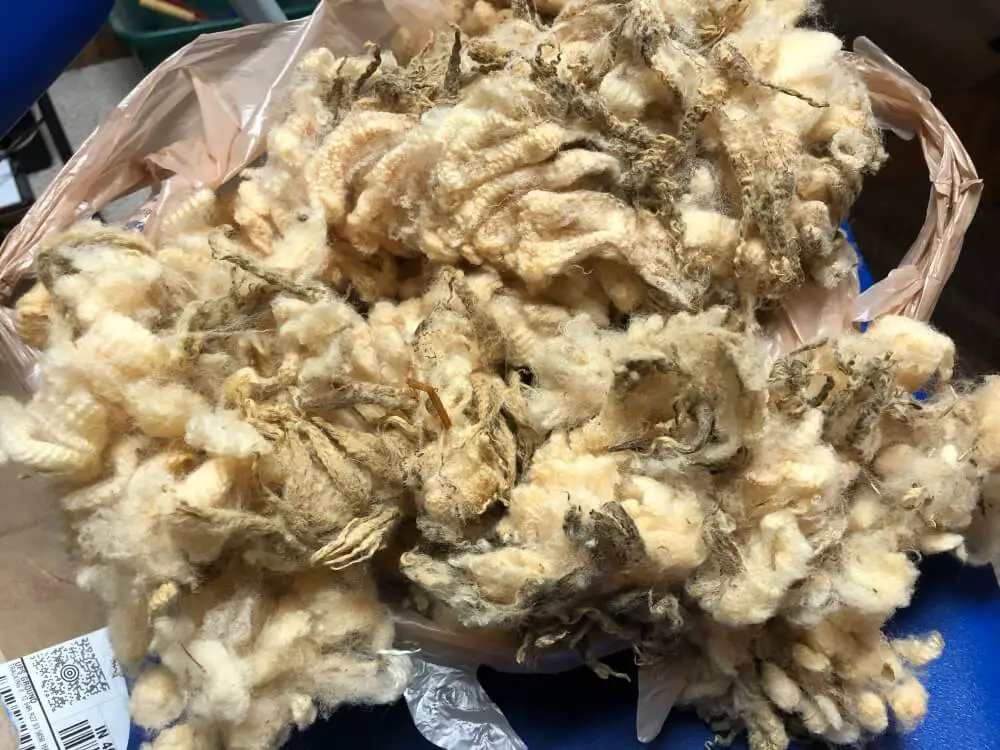
To properly clean raw wool, you need to gather a few essential supplies before beginning the process. This will ensure that you have everything you need on hand to clean your wool effectively and prevent felting.
1. Gather Materials
To get started washing your fleece, here are things you need to make sure you have
- Your raw wool (obviously)
- A large sink, tub, or basin
- A gentle soap like Dawn or a Wool Wash (Here’s a link to the kind I use, see on Amazon)
- A mesh bag/lingerie bags (not required but I highly recommend using one, see on Amazon)
- A few clean bath towels
Once you have everything you need gathered up, it’s time to inspect the fleece itself.
2. Prepare the Fleece
Most fleeces that you will buy will already be skirted. Skirting is the process of laying an entire fleece out on a skirting table and removing the unusable parts of the fleece from areas such as near the tail and at the base of the neck that contains the most lanolin, dirt, vegetable matter, and sometimes poop.
I won’t be going into how to skirt a whole fleece in this post, that’s another matter entirely, if you need to know how to skirt a fleece, there are some great YouTube videos showing the process.
To prepare your skirted fleece for washing, you’ll want to pull the locks apart and layer them into your garment bag in rows.
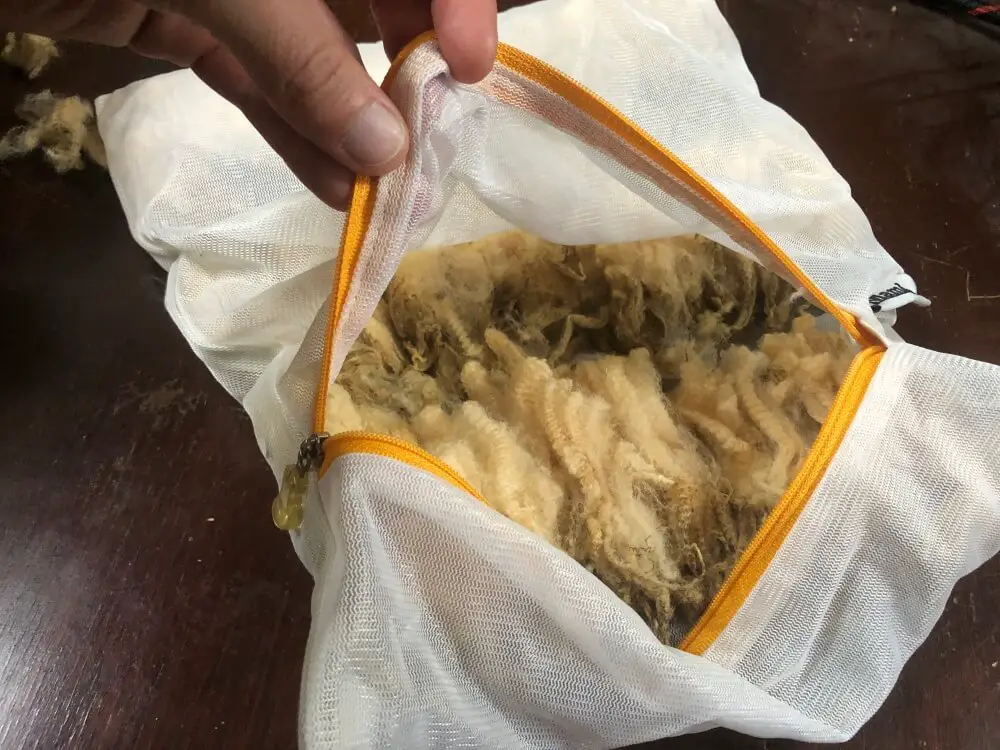
This will enable the tips of the fleece, which are usually matted with lanolin, to separate during the washing process.
While you’re doing this, keep an eye out for second cuts. Second cuts are little chunks of wool created when the shearer cuts once to get the majority of the fleece and then has to go down again to get more fleece off, hence the name second cuts.
These little guys won’t cause any problems during the washing, but they’re too short to spin so you don’t want them in your finished fiber.
If you’re not planning on using a garment bag, I would recommend you not pull off the individual locks. Trying to fish them all back out of the sink can be quite annoying, ask me how I know…
Instead, you can rip off a big chunk of wool from the fleece making sure it’s not any larger than the sink you plan to wash in. This chunk of fleece will more or less stay together through the washing process making it easier to remove the clean fleece from the water.
Once you have your raw wool ready to go, it’s time to get the soapy water ready.
3. Prepare Soap Bath
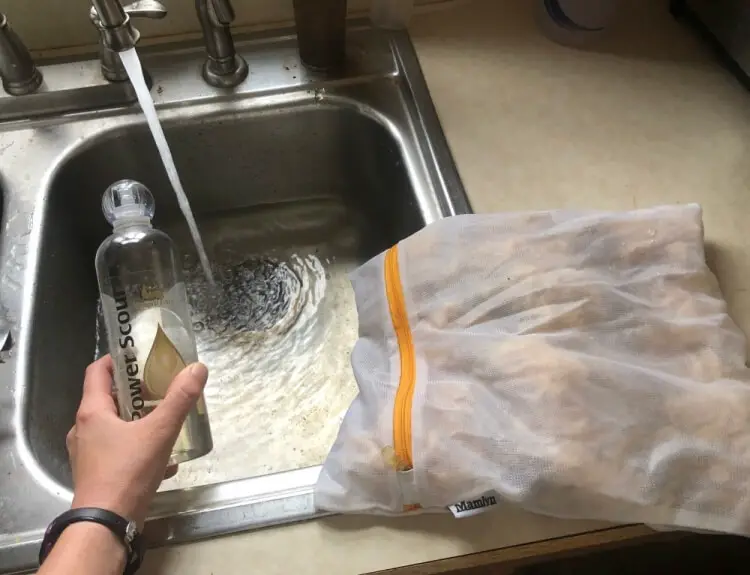
I know it seems like a simple task to fill a sink with soap water but there are a few tips you can use to make your life easier.
First, you need to choose the water temperature. There are a few things to consider when deciding how hot you want your water.
If your fleece has a lot of wool grease (lanolin) or is very dirty, hot water is best. The heat from the water will help break down the grease which traps in a lot of dirt and grime.
However, it is easier to felt wool if you’re using very hot water as opposed to using lukewarm or cool water. The magic recipe for felting wool is heat plus agitation. Remove one of those and you won’t have any issues.
I wash my fleece with hot water with no issues but all it takes is one wrong swish to ruin a whole batch of wool.
If your fleece is relatively clean or you’re nervous about felting your wool, then you can go with lukewarm water instead.
Once you’ve settled on a temperature, fill your sink with water. Once your sink is full, then and only then, add your soap.
You don’t need very much soap, if you’re using a wool wash, the package will tell you the amount of detergent to use for the amount of fleece you will be washing.
Adding your soap after the water is added will decrease the amount of suds you have to contend with. I know for us suds equals clean, but the soap will clean just the same.
Not having suds makes it easier to see the wool and it’s much easier to rinse the soap out of the wool if they’re aren’t a lot of suds.
Now, it’s finally time to wash your raw wool
4. Wash Wool
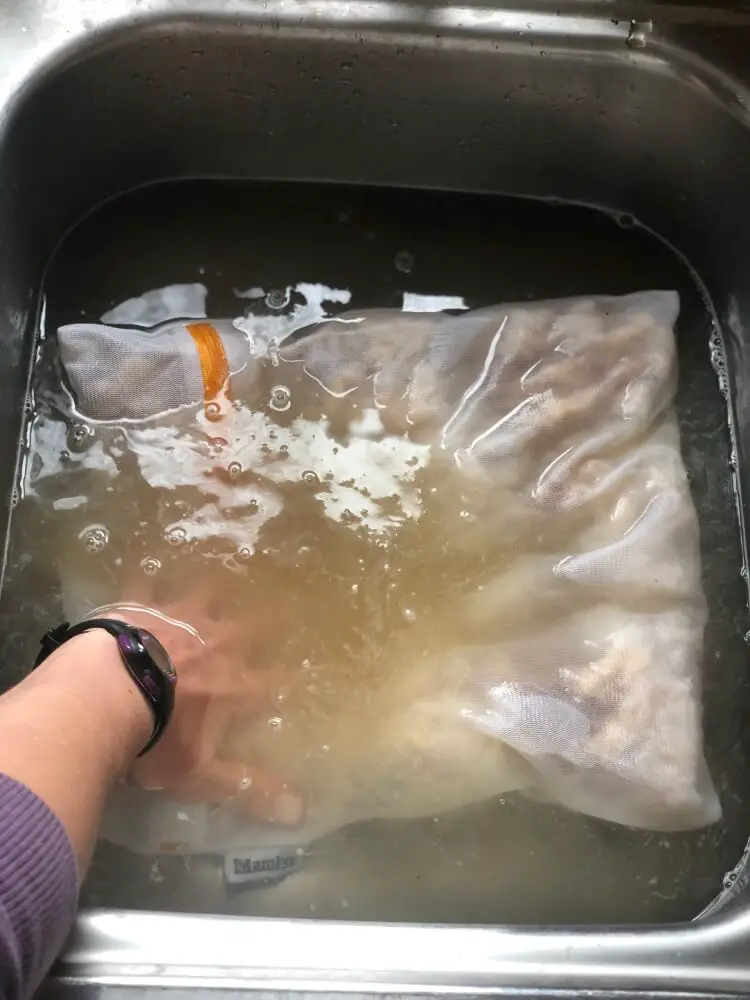
With your soapy bath ready and your wool prepared, it’s time to combine the two.
Put your raw wool in the water and press down on it gently. If your water is really hot, you can use a wooden spoon or spatula to press it down into the water.
You will have to hold the wool underwater for a few seconds so all the fibers can be fully saturated. You can see in the picture above all the lanolin coming out of the raw wool, this was only after a few seconds in the soapy water.
Do not agitate it. I cannot emphasize this enough, do not agitate your wool. Don’t stir it, don’t flip it over, don’t run or pour more water in your sink.
Remember, the recipe for disaster/felting, is heat plus agitation. So, to make sure you don’t felt your wool, you need to be as gentle as possible.
If you have an especially greasy fleece, you can help it along by continuing to press down gently and then release the wool. This gentle up-and-down movement shouldn’t be enough to felt the wool as long as you go nice and slow.
This is what I do when I clean my wool and it hasn’t failed me yet… knock on wood…
Once your wool is fully saturated, you’ll want to let it soak for at least 10 minutes. Since you can’t agitate wool, this soaking is how the soap does its job and gets all the grim out.
5. Remove Wool from Water
I know it might seem kind of silly to have an entire step dedicated to pulling your wool out of the water, but we’re dealing with delicate stuff here.
Once your soak is done, gently remove the wool from the water. You might be tempted to drain the sink or dump the tub out with wool still inside, don’t do it!
The agitation caused by all that moving around could cause the wool to felt.
So, gently pull your garment bag or chunk of wool out of the sink and gently squeeze out any excess water. Only squeeze straight down without any wringing or twisting, again, this could felt it.
You don’t have to get all the water out, just squeeze it enough to get the excess bits.
Before you drain your dirty water, put your hand in the water and take note of the temperature. Whatever temperature it is, you’ll want to try and use close to that same temperature in your rinse water.
6. Rinse Wool
To rinse your wool, you’re going to refill your tub or sink with clean water. Try to match the temperature of your rinse water to the temperature of the water that the wool just came out of.
Why, you ask? Because rapid changes in temperature can also felt wool.
So, if the water you just took the wool out of was warm, you should rinse it in warm water. If you take wool out of cool water and then dunk it directly into hot water or vice versa, this could be enough to shock the little fibers into felting. I know it would shock me.
The temperature doesn’t have to be exact, no need to break out a thermometer, just try to get it close so it’s not a rapid change.
Once your wash tub is full and the faucet is off, add your wool to the water and press down gently. Just like you did while washing, you can press up and down on it slowly and gently but don’t swish or agitate it.
Then, let the wool soak for another ten minutes.
Repeat the process of taking the wool out and gently squeezing it and then take a look at your wool. Does it look like there’s still some lanolin, dirt, or vegetable matter in it? If it does, then you might have to do a second wash and rinse cycle.
Does it look clean and gorgeous after the first wash? If it does, then great, you’re ready to lay it out to dry.
7. Dry Wool
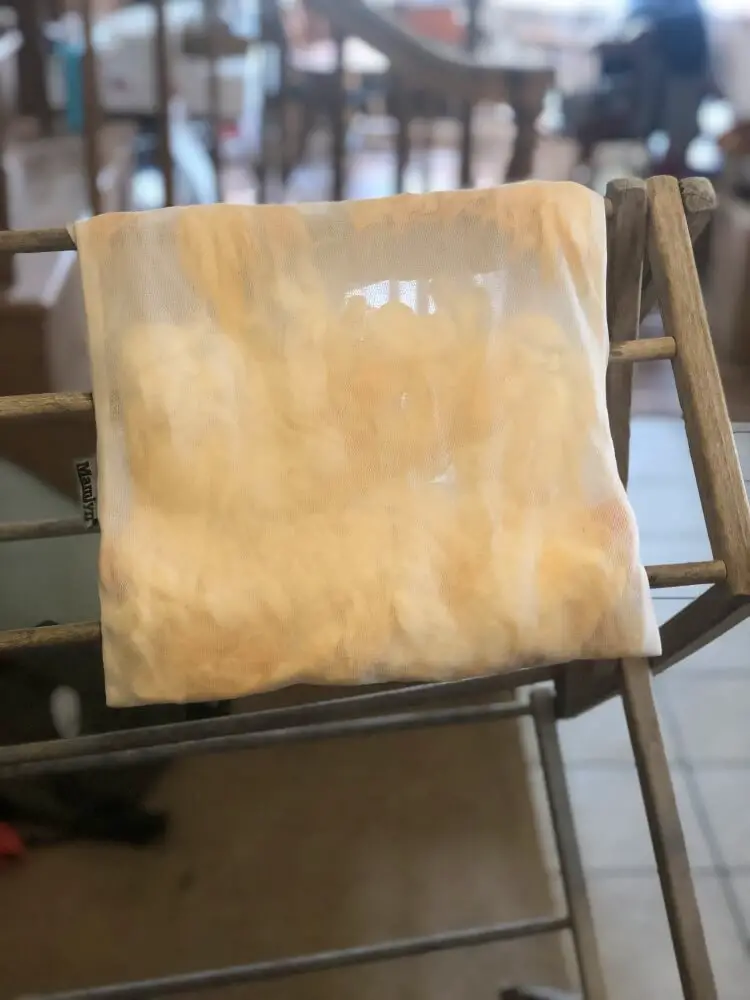
The first step in drying the wool is to lay the wool flat on a clean towel, gently roll it into the towel, and squeeze it as you go. Rolling it in the towel will help absorb even more water which will help decrease the drying time. Wool takes forever to dry.
This is going to sound weird, but if you have a salad spinner, you can spin your wool in a salad spinner and it is an excellent way to get out all that extra water.
When you think about it, a salad spinner is just a mini version of the spin cycle on your washing machine.
Then, lay the wool out on a drying rack in a well-ventilated area away from direct sunlight or heat sources.
Wool is especially fragile while it’s wet so allow the wool to air dry completely before handling or storing it. Storing wool that’s not fully dry could cause the wool to mold and nobody wants that.
5 Tips to Prevent Felting
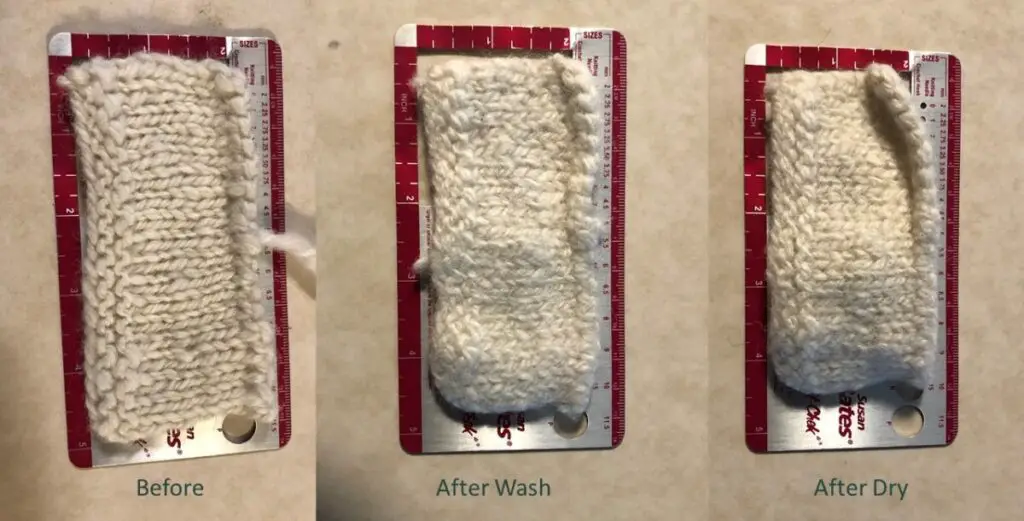
I’ve mentioned most of these tips within the tutorial above, but in case you were skimming or missed them, I have them laid out here for you.
1. Be Gentle
The best way you can prevent felting is to be gentle with the wool. Don’t agitate it, don’t twist it, don’t wring it, and generally don’t strain it in any way while it’s wet.
If you do this, your odds of felting your fiber go down a ton.
2. Avoid Rapid Temperature Changes
I mentioned this in the tutorial but I’ll explain it again for you here.
You want to avoid causing any rapid temperature changes or temperature shock to your wet wool. This rapid change can cause felting.
This means keeping your rinse water and wash water at a similar temperature and don’t take the wool out of a hot water bath and put it in the freezer.
I know that seems like an extreme example but I wanted to make a point.
3. Don’t Wring Out Excess Water
This one is a form of agitation but is probably something that people don’t even realize they do.
Don’t wring the water out of the wool. I know it’s the easiest way to get the most excess water out, but that wringing causes enough agitation that it will felt the wool.
Instead, squeeze gently from the top down and then roll the wool or yarn into a towel. Once you have a wool burrito, squeeze the towel from one end to the other to soak up even more water.
If you do both of these things, you will probably remove more water from the wool than you would if you just wrung (wringed? wrang? English is the worst) the wool out.
4. Use a Garment Bag
Using a garment bag to wash your wool in will help keep the wool together and not float around. This makes it a lot easier to remove from the wash and easier to control.
Keeping your wool contained and not floating freely is an easy way to prevent excess agitation.
5. Use a Gentle Soap or Wool Wash
Last but not least, make sure you’re using a wool-safe soap or a wool wash. Some laundry detergents have enzyme stain removers which are great for getting food stains out of clothes.
However, food stains are protein-based stains, and wool (and all animal fibers) is a protein-based fiber. That means that those same enzymes that break down the stains will break down the wool fibers as well.
This doesn’t cause felting but it can cause major and irreparable damage to your fleece.
Dawn dish soap and most mild detergents are wool safe and are a good cheap alternative to wool washes.
If you want something specifically for wool, you can get a soap called a wool wash. If you want some more info about wool washes, check out this post: 4 Wool Wash Facts Every Wool Lover Needs to Know
How to Store Wool Safely
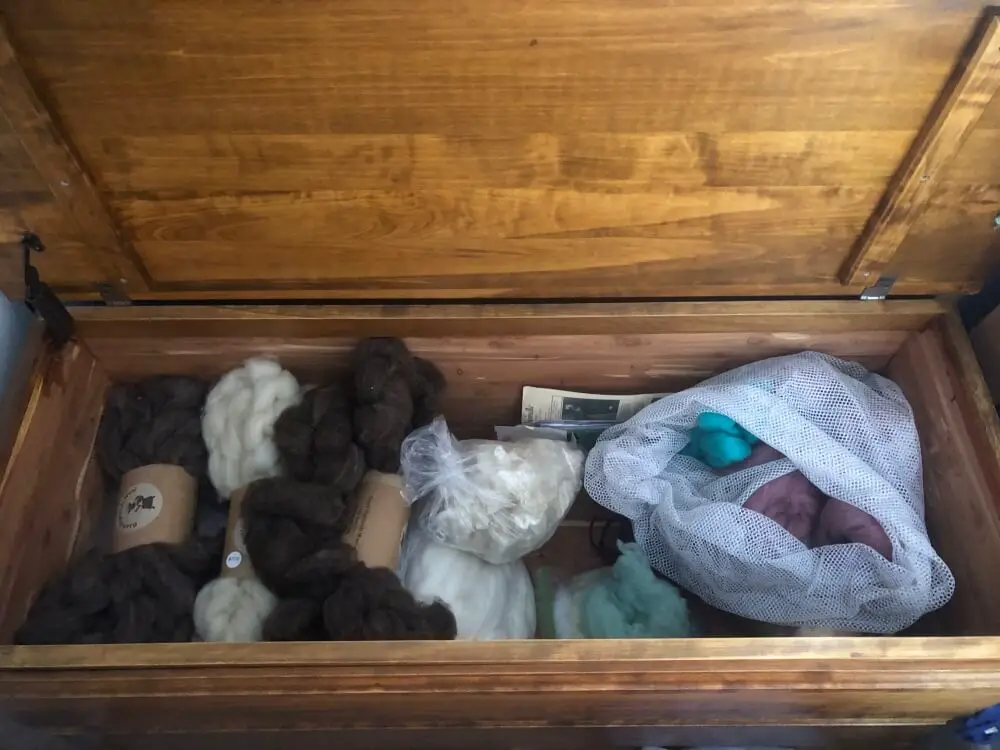
Now that you’ve got your nice clean wool, you’ll want to make sure you store it properly so nothing happens to it.
You should try and store your wool in a cool dry place away from direct sunlight. Sunlight can damage and yellow the wool fibers which would ruin all your hard work. If you store wool somewhere humid it could cause the wool to get damp and possibly even mold.
Bugs and moths might be a concern of yours so let’s talk about how to keep them away.
First off, most bugs or moths are only attracted to dirty wool with the lanolin still on it, if your wool is clean, you don’t need to worry about them as much.
But, there are a few things you can do. Storing your wool in a cedar chest or dresser is a great way to keep bugs out, cedar is a natural pest repellant.
However, cedar chests are expensive and not easy to find, so instead, you can make yourself a little bug-repellant sachet.
Using a little breathable bag, take a few cotton balls and add a few drops of cedar essential oil and a few drops of lavender essential oil. Lavender is also a natural pest repellant.
Then, put the cotton balls in the bag and throw the bag in with your wool. This will help keep pests away and make the whole thing smell nice.
Related Questions
Does Yarn Shrink When Washed?
Yarn made out of animal fibers, such as wool, alpaca, and cashmere, will shrink if not washed properly. Synthetic yarns, like acrylic, and plant-based yarns, like cotton, will not shrink when washed. For a more thorough explanation and for photo evidence, check out this post: Does Yarn Shrink When Washed? (4 Different Yarns Explored)
Can You Put Wool in the Dryer?
You should not put wool in a commercial dryer, wool should be laid out flat to dry out of direct sunlight. If you put wool in a dryer it will felt and shrink. But, if you have yarn that is superwash wool, or a wool garment made of superwash wool, these things can be put in the dryer. For more information, check this out: Can You Put Wool in the Dryer? (How to Avoid Wool Shrinkage)
How Do You Wash Alpaca?
To wash Alpaca by hand, fill a sink or tub of hot water, add a wool-safe soap, gently press the socks into the water, and let them soak. Remove the soapy socks, refill the tub with hot water, and let them soak again to rinse the soap out. Remove the socks, gently squeeze out excess water, and lay them flat to dry out of direct sunlight. Click here for the full tutorial: How to Wash Alpaca Socks: Easy Care and Cleaning

